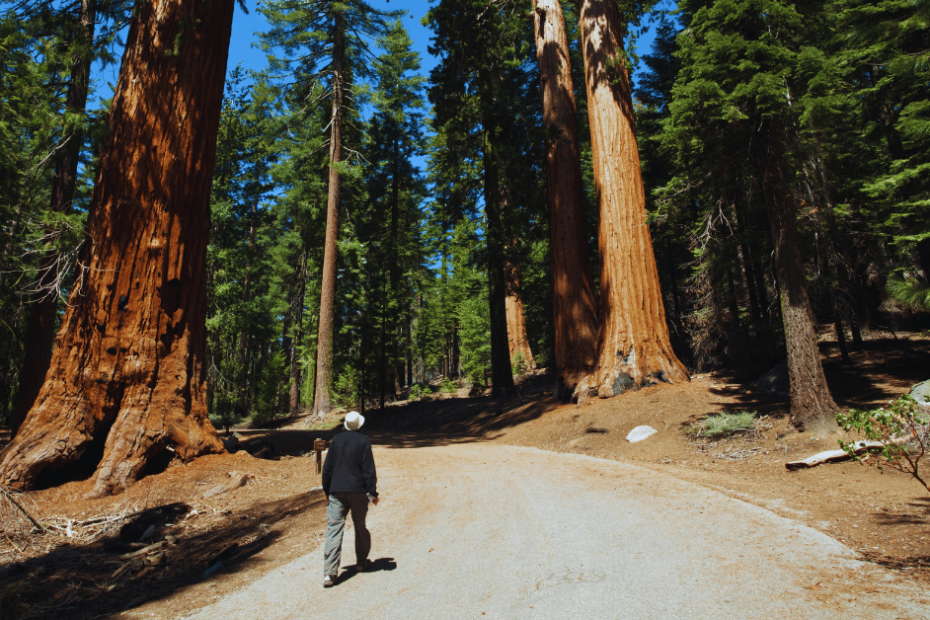Imagine embarking on an unforgettable road trip that takes you through some of California’s most breathtaking landscapes. Starting from the majestic granite cliffs of Yosemite National Park, your journey winds down to the towering giants of Sequoia National Park. This loop isn’t just a drive; it’s an adventure filled with awe-inspiring vistas, serene forests, and countless opportunities for exploration.
As you traverse this scenic route, you’ll encounter a variety of experiences, from hiking iconic trails to discovering hidden gems off the beaten path. Whether you’re a seasoned traveler or a nature enthusiast, the Yosemite to Sequoia Mountain Loop offers something for everyone. Get ready to pack your bags and hit the road for an epic journey through two of America’s most iconic national parks.
Key Takeaways
- Scenic Diversity: The road trip from Yosemite to Sequoia features stunning landscapes, from Yosemite’s granite cliffs to Sequoia’s colossal trees, offering an array of picturesque vistas and natural wonders.
- Best Travel Seasons: Visit during summer for full park access but expect crowds, or enjoy milder weather and fewer visitors in spring and fall. Winter caters to those interested in serene landscapes and winter sports, though some roads may be closed.
- Permits and Fees: Be aware of necessary park entrance fees, wilderness permits for backcountry camping, and campground reservations, especially during peak seasons.
- Essential Packing: Pack layers of clothing, camping gear, navigation tools, health essentials, and personal items to ensure a comfortable and enjoyable trip.
- Accommodation and Dining: Lodging options range from hotels to campgrounds, with varied amenities. Dining includes restaurant options and convenient snack bars within the parks.
- Must-See Attractions: Key highlights include hiking trails like the Mist Trail, viewpoints such as Tunnel View and Glacier Point, and remarkable trees including the General Sherman Tree and Grizzly Giant.
Planning Your Road Trip Yosemite to Sequoia Mountain Loop

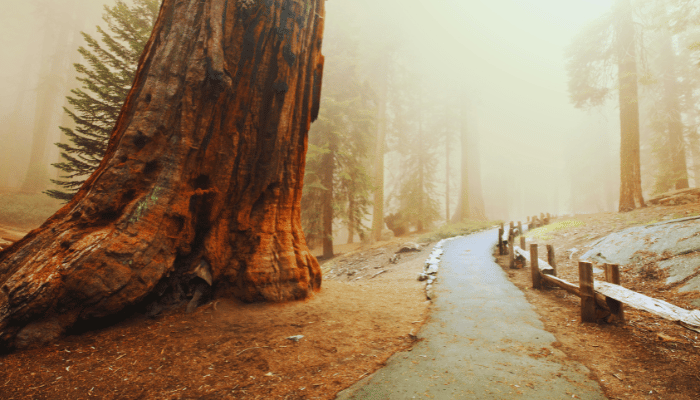
Best Time to Visit
The best time to visit the Majestic Mountain Loop, which includes Yosemite, Sequoia, and Kings Canyon National Parks, depends on your preferences and what you want to avoid:
- Summer (July, August, September): These months offer the best access to all areas of the parks, including the Kings Canyon Scenic Byway and Tioga Road in Yosemite. But, this is peak season, and the parks will be crowded. Be prepared for hot weather and the risk of wildfires.
- Spring and Fall: These seasons provide milder weather and fewer crowds. But, some roads like Tioga Road and Glacier Point Road in Yosemite may still be closed in late spring, and they close again in mid-November for winter.
- Winter: If you prefer winter sports and don’t mind road closures, winter can be a serene time to visit. But, many roads and facilities will be closed due to snow.
Necessary Permits and Fees
Ensure your trip goes smoothly by knowing the necessary permits and fees:
- Park Entrance Fees: Yosemite, Sequoia, and Kings Canyon National Parks each charge an entrance fee. You can purchase a combined pass to save money if you plan to visit multiple parks.
- Wilderness Permits: If you plan on backcountry camping, you will need wilderness permits, which can be reserved in advance or obtained on a first-come, first-served basis at ranger stations.
- Campground Reservations: Popular campgrounds often require reservations, especially during peak season. Check availability and make reservations well in advance to secure your spot.
Essential Packing List
Pack smart to ensure a comfortable and enjoyable trip:
- Clothing: Layers to adjust to changing weather, a sturdy pair of hiking boots, and a waterproof jacket.
- Camping Gear: Tent, sleeping bag, and cooking supplies if you plan on camping.
- Navigation Tools: Maps, compass, or GPS to help you navigate the parks’ vast landscapes.
- Health Essentials: Plenty of water, high-energy snacks, sunscreen, bug repellent, and a first-aid kit.
- Personal Items: Toiletries, camera, and binoculars for wildlife spotting.
Closest Airports
Consider the following airports for the most convenient access to the Majestic Mountain Loop:
- Fresno Yosemite International Airport (FAT): Roughly 2 hours from both Yosemite and Sequoia National Parks, making it the most central option.
- Sacramento International Airport (SMF): About 3.5 hours from Yosemite and more convenient if coming from Northern California.
- Los Angeles International Airport (LAX): Around 4.5 hours from Sequoia and Kings Canyon National Parks, suitable for those extending their trip to Southern California.
Using these tips, you’re ready to begin on a memorable road trip through some of California’s most stunning landscapes.
Day 1: Exploring Yosemite National Park
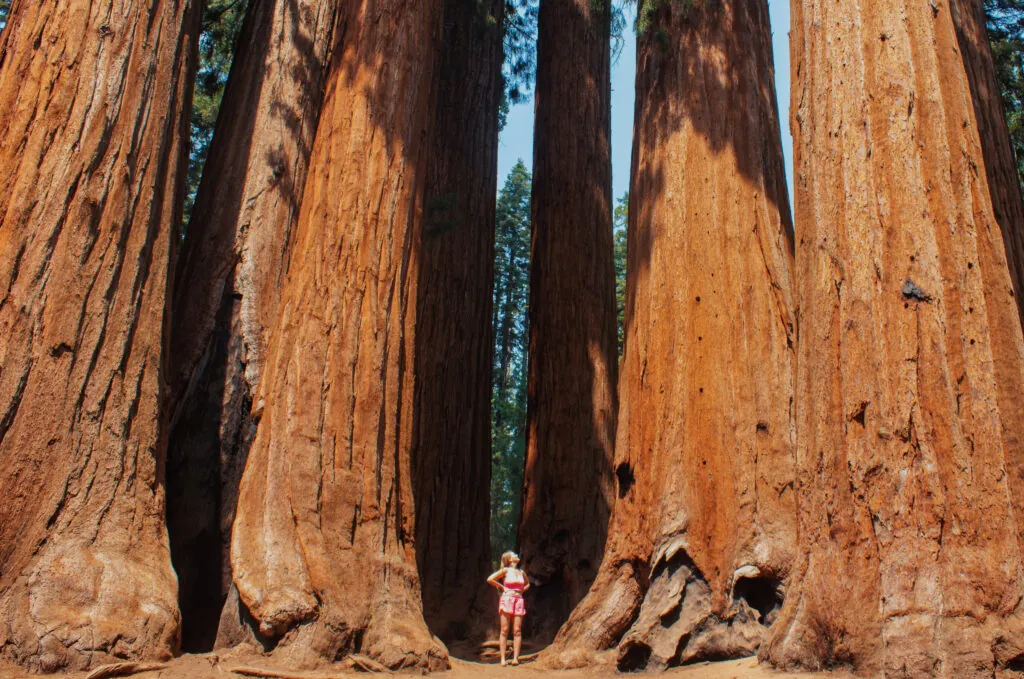
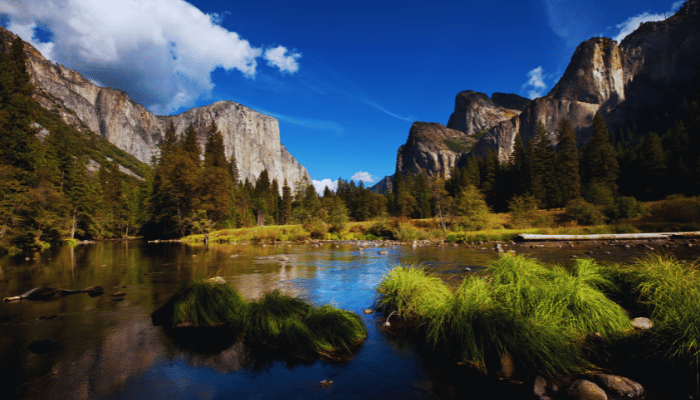
Snap Photos at Tunnel View
Start your adventure at Tunnel View, Yosemite’s iconic viewpoint. You’ll be awestruck by the panoramic vistas of El Capitan, Half Dome, and Bridalveil Fall—all spectacular scenes that make this spot a photographer’s dream. Located off Wawona Road (Hwy 41), it’s easily accessible and well-signposted, so keep your camera ready for some unforgettable snaps.
Hike the Mist Trail
After soaking in the views at Tunnel View, make your way to the Mist Trail. This popular hike in Yosemite Valley offers a steep 1.2-mile ascent to Vernal Fall, a stunning 317-foot waterfall. Prepare for wet conditions as the trail often lives up to its misty name, especially in spring and early summer. If you’re feeling energetic, continue another 1.5 miles to Nevada Fall, which impresses with a height of 594 feet. Along the way, you’ll encounter granite staircases and get a close-up view of the powerful cascades, making this hike both challenging and exhilarating.
Watch Sunset at Glacier Point
Cap off your first day by catching the sunset at Glacier Point. Accessible via Glacier Point Road during the warmer months, this vantage point grants sweeping views of Yosemite Valley, Half Dome, and the High Sierra. The changing colors of the sky paint a mesmerizing backdrop, making it an ideal spot for winding down your day. Be sure to bring a light jacket, as temperatures can drop quickly after sunset.
Day 2: Discovering Yosemite’s Hidden Gems
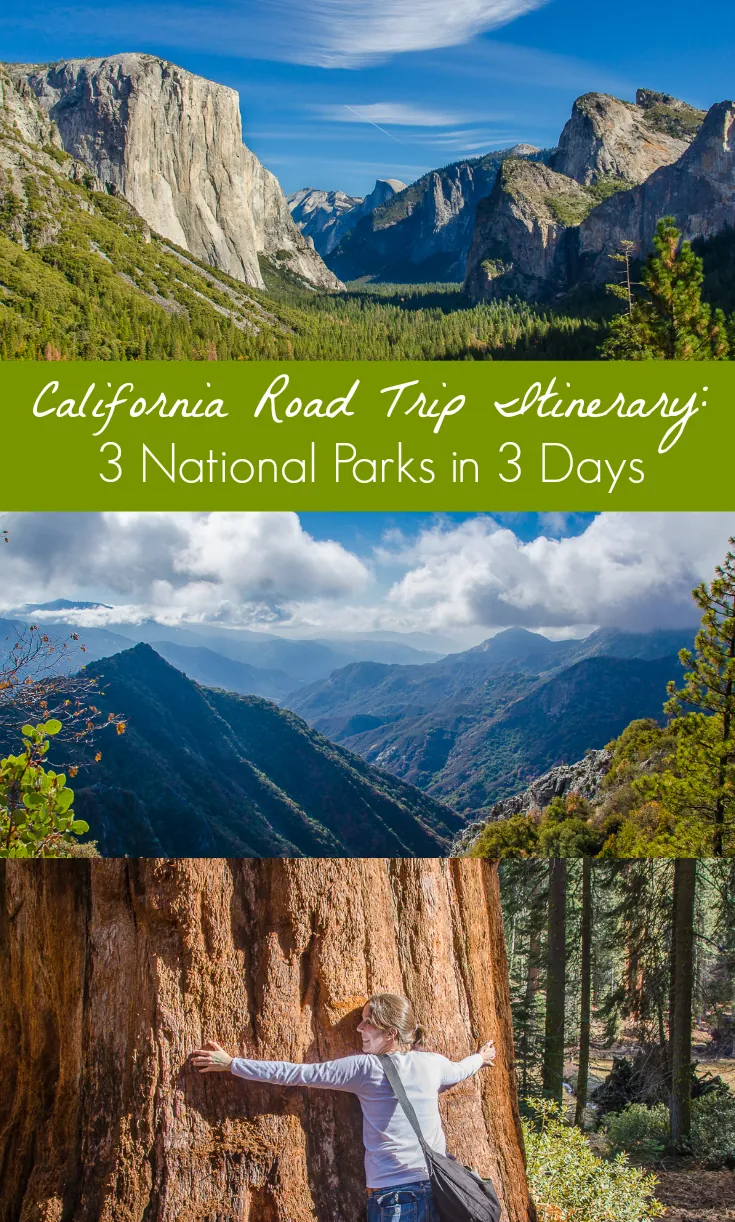
Prepare to uncover Yosemite’s hidden gems on your second day. From iconic valleys to scenic drives and towering trees, this day is brimming with adventure.
Explore Yosemite Valley
- Yosemite Falls: Start your day early at Yosemite Falls to avoid crowds. The Lower Yosemite Fall trail offers a short, paved loop giving you amazing views of the waterfall.
- Tunnel View: Don’t miss Tunnel View for a panoramic scene of El Capitan, Half Dome, and Bridalveil Fall. This spot is a photographer’s paradise.
- Bike through Yosemite Valley: Spice up your exploration by renting a bike at Yosemite Valley Lodge or Curry Village. Traverse the 12-mile paved path to enjoy the valley’s beauty at your own pace.
Drive Tioga Road
- Olmsted Point: Drive along Tioga Road to Olmsted Point. This overlook offers a unique perspective of Half Dome and Tenaya Canyon, ideal for breathtaking photos.
- Tenaya Lake: Stop by Tenaya Lake, known as Yosemite’s high country jewel. Its crystal-clear waters and granite surroundings invite you for a refreshing dip or a peaceful picnic.
- Tuolumne Meadows: Explore Tuolumne Meadows, renowned for its sprawling flower fields and scenic hiking trails. Opportunities abound for photography, hiking, and soaking in serene views.
- Grizzly Giant: Stand in awe of Grizzly Giant, Mariposa Grove’s colossal sequoia, estimated to be over 1,800 years old. Its sheer size will leave you speechless.
- California Tunnel Tree: Walk through history as you pass through the tunnel carved in the California Tunnel Tree. This tree was hollowed out in 1895 to allow coaches to pass through.
- Big Trees Loop: Take the Big Trees Loop trail for a family-friendly hike. This 0.3-mile easy trail circles around some of the oldest and largest trees in the grove.
Embrace the diversity of Yosemite’s offerings, and make sure not to rush through these treasures. Each stop provides a unique experience that adds depth to your adventure.
Day 3: Transition to Kings Canyon National Park

Prepare for an exhilarating journey as you transition from Yosemite and Sequoia to Kings Canyon National Park. Today’s adventure will guide you through breathtaking landscapes and captivating attractions.
Drive the Kings Canyon Scenic Byway
Grab your camera and hop in the car to drive the stunning Kings Canyon Scenic Byway (Highway 180). This picturesque route takes you deep into the heart of Kings Canyon, showcasing some of the park’s most spectacular vistas. From majestic granite cliffs to lush forests, each twist and turn offers a new perspective. Remember, this road can be closed well into June due to snow and again by mid-November for winter, so plan accordingly.
Hike to Zumwalt Meadow
Lace up your hiking boots and head to Zumwalt Meadow. This picturesque spot is one of Kings Canyon’s must-see locations. The 1.5-mile loop trail around the meadow features boardwalks and river views, perfect for photographers and nature enthusiasts alike. Enjoy serene meadows surrounded by towering peaks, giving you a true sense of the park’s natural beauty.
Visit General Grant Grove
Make sure to visit General Grant Grove, home to some of the world’s largest trees. The General Grant Tree, dubbed the Nation’s Christmas Tree, stands as a living testament to the awe-inspiring power of nature. Enjoy an easy, family-friendly trail that loops around the grove, allowing you to get up close to these ancient giants and learn about their historical significance.
Explore the Magic of Kings Canyon!
This diverse array of activities ensures that whether you’re a nature lover or an adventure seeker, Kings Canyon National Park offers something truly spectacular for everyone.
Day 4: Adventures in Kings Canyon National Park
Your fourth day in Kings Canyon National Park promises thrilling adventures and stunning sights.
Tour Boyden Cavern
Current Status: As of 2023, Boyden Cavern is closed due to road damage from storms. Always check the current status on the park’s website before planning your visit.
Alternative: If Boyden Cavern remains closed, hike the 1.5-mile Big Stump Trail in Sequoia National Park. This trail offers a fascinating look at the remains of giant sequoias that were cut down in the 1800s.
View Grizzly Falls
Location: Grizzly Falls is nestled within the Kings Canyon National Park area, an often-overlooked scenic gem.
Access: Make sure to check the park’s website for any road closures or trail conditions before heading out. Grizzly Falls is an easy stop along the route and offers a serene spot perfect for a picnic or a photography session.
Panoramic Point Overlook
Sweeping Views: Don’t miss Panoramic Point Overlook, which delivers breathtaking views of the park’s rugged terrain. Here, you can soak in the vastness of the high Sierra world, making it a perfect spot for both relaxation and photos.
Easy Access: The overlook is accessible via a short, easy trail, making it suitable for visitors of all ages and fitness levels. For real-time conditions and accessibility updates, it’s always best to refer to the park’s official resources.
Day 5: Immersed in Sequoia National Park
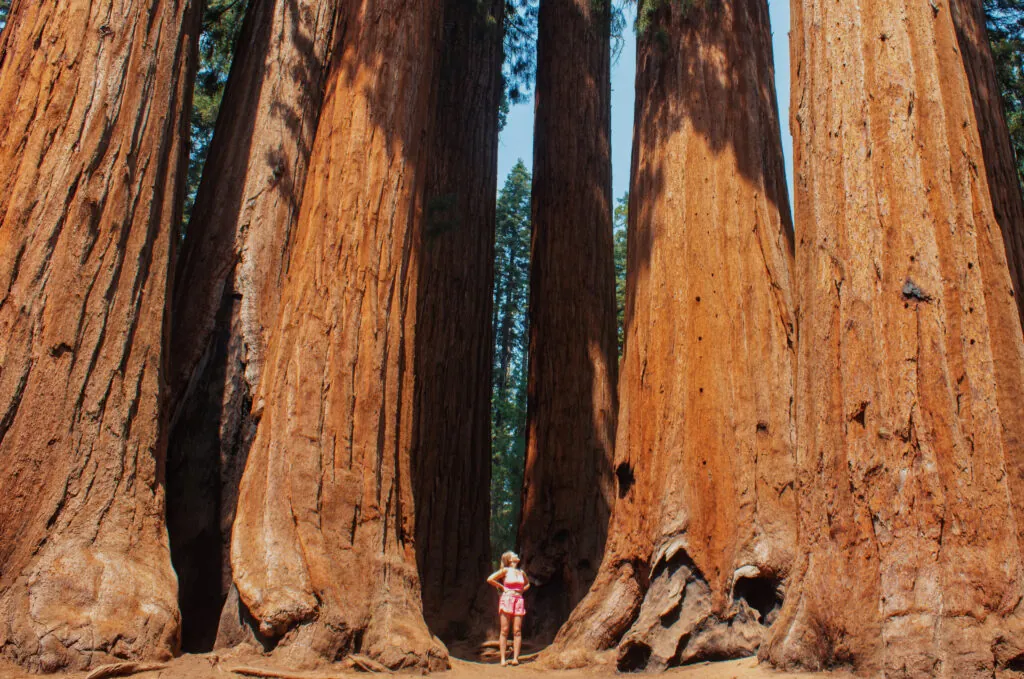
Day 5 of your Majestic Mountain Loop adventure dives deep into the wonders of Sequoia National Park. From granite domes to towering trees, you’ll find plenty to explore and admire.
Climb Moro Rock
Climb 350 steps up Moro Rock for a breathtaking experience. This prominent granite dome offers panoramic views of the surrounding valley. The 0.5-mile hike takes about 30 minutes and is moderately difficult. Arrive at sunrise or sunset for unrivaled scenery—perfect for capturing frame-worthy photos. For safety, hold onto the railings as some sections can be narrow and steep.
Stroll Through the Giant Forest Museum
Stroll through the Giant Forest Museum to start your day. This informative hub delves into the park’s history, geology, and the world of giant sequoias. Interactive exhibits make learning fun for all ages. You’ll come away with a deeper appreciation for the park’s natural wonders and a solid understanding of what makes these towering trees so special. The museum is a fantastic kickoff for your Sequoia explorations.
See the General Sherman Tree
See the General Sherman Tree, the world’s largest tree by volume. Located in the Giant Forest, this monolithic sequoia is a must-see. A short 0.8-mile round-trip trail brings you face-to-face with this natural marvel. Well-paved and accessible, the path ensures everyone can join this awe-inspiring experience. Interpretive signs along the way provide fascinating tidbits about the tree’s colossal size and age.
Top Attractions
- Moro Rock: 0.5-mile, 30-minute hike, over 350 steps.
- Giant Forest Museum: Interactive exhibits on trees and geology.
- General Sherman Tree: Accessible 0.8-mile round-trip trail to the largest tree by volume.
Hidden Gems
Discover hidden gems like Crescent Meadow, often called the “Gem of the Sierra.” Explore unique spots such as Tharp’s Log and the serene beauty surrounding this picturesque meadow.
Accommodations
| Accommodation | Type | Price Range | Amenities |
|---|---|---|---|
| Wuksachi Lodge | Hotel | $150-$300 | On-site dining, guided tours, free Wi-Fi |
| Lodgepole Campground | Campground | $22-$45/night | Fire rings, picnic tables, restrooms |
| John Muir Lodge | Hotel | $125-$250 | Historic setting, rustic décor, restaurant |
Dining Highlights
- Wuksachi Lodge Restaurant: Feasts featuring local flavors and seasonal ingredients.
- The Peaks Restaurant: Casual dining with panoramic window views.
- Snack Bars: Convenient options available at visitor centers.
- Getting Around: Shuttle services run through the park, reducing parking hassles.
- Seasonal Must-Knows: Snow chains may be required in winter; spring and fall offer mild weather.
- Sustainability Tips: Use refillable water bottles and stick to marked trails to minimize impact.
Embrace the full spectrum of experiences that Sequoia National Park offers, ensuring a memorable and fulfilling end to your Majestic Mountain Loop road trip.
Day 6: Final Day in Sequoia National Park
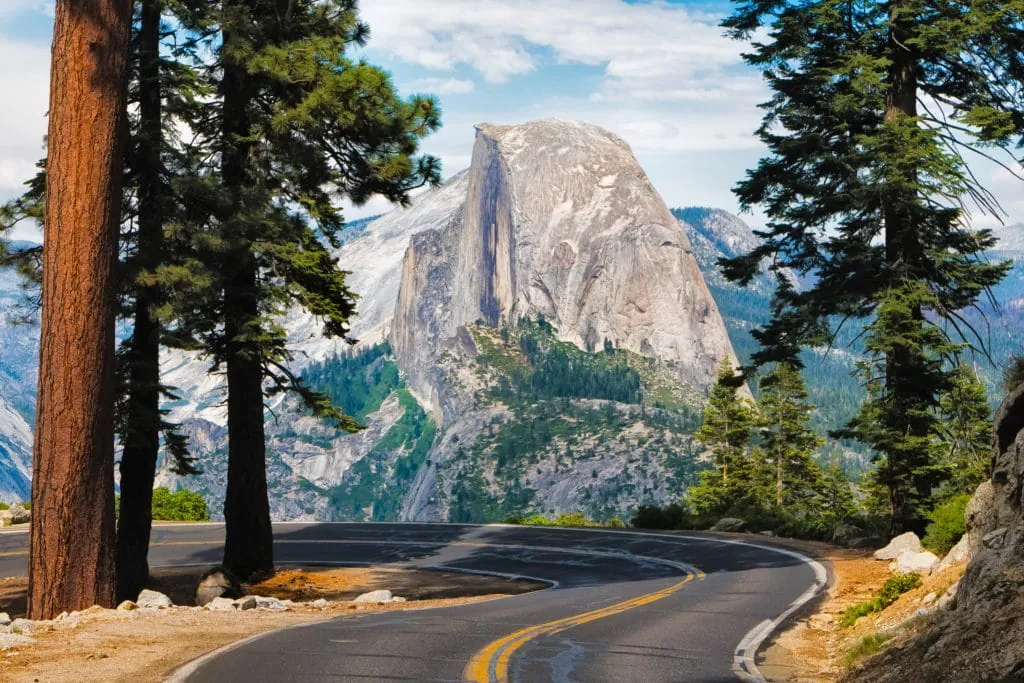
Your final day in Sequoia National Park is packed with must-see attractions and relaxing spots. Immerse yourself in nature as you explore towering sequoias and breathtaking landscapes.
Drive Through the Tunnel Log
Driving through the Tunnel Log is a quintessential Sequoia experience. Created in 1937 from a fallen 2,000-year-old sequoia, this tunnel is an 8-foot-high passage carved directly through the tree. It’s perfect for photo ops, so grab your camera. But, if your vehicle is taller than 8 feet, you’ll need to take a detour around the log.
Explore Crystal Cave
Exploring Crystal Cave is a highlight for many visitors. This marble cavern features stunning stalactites and stalagmites, making it a geological wonder. Access is only through guided tours, so check the park’s website for availability and seasonal conditions. The 45-minute tour costs around $16 for adults and $8 for children, and sturdy footwear is recommended as the cave floor can be slippery.
Relax at Crescent Meadow
Relaxing at Crescent Meadow is the perfect way to unwind. Known as the “Gem of the Sierra,” this lush meadow is surrounded by towering sequoias. It offers several easy walking trails, making it ideal for a leisurely stroll. Keep an eye out for wildlife, such as deer and black bears, that frequent the area. Picnic tables and rest areas provide a great spot to enjoy a packed lunch amid serene surroundings.
Accommodations in Sequoia National Park offer a variety of options. Here’s a comparative table to help you choose the best stay based on your preferences:
| Accommodation | Type | Price Range (per night) | Key Features |
|---|---|---|---|
| Wuksachi Lodge | Hotel | $200 – $300 | Rustic charm, on-site dining, close to main attractions |
| Lodgepole Campground | Campground | $20 – $40 | Family-friendly, near visitor center and trails |
| Mineral King Area Cabins | Cabins | $150 – $250 | Secluded, scenic views, limited amenities |
When it comes to dining, the park offers several options:
Dining Highlights:
- The Peaks Restaurant at Wuksachi Lodge: Serves hearty meals with locally-sourced ingredients.
- Pole Crossing Camp Store: Provides snacks, beverages, and quick meal options.
- Picnicking: Perfect for Crescent Meadow or Giant Forest, where you can enjoy a meal surrounded by nature.
For transportation, it’s best to have your vehicle, as many park attractions are spread out. Shuttle services are available seasonally and can be an excellent option for getting around without the hassle of driving.
- Best Time to Visit: Late spring to early fall for mild weather and full access.
- Sustainability Tips: Use refillable water bottles, follow Leave No Trace principles, and be mindful of wildlife.
- Budget Considerations: Plan on around $35 for a weekly vehicle pass, and consider camping for a budget-friendly accommodation option.
Begin on your journey through Sequoia National Park equipped with these tips, ready to create unforgettable memories in one of America’s most majestic landscapes.
Conclusion
Embarking on the Yosemite to Sequoia Mountain Loop is more than just a road trip; it’s an unforgettable adventure through some of California’s most breathtaking landscapes. From the iconic views of Yosemite to the towering giants of Sequoia, each day promises new discoveries and awe-inspiring experiences.
With practical tips and a detailed itinerary, you’re well-prepared to make the most of your journey. Whether you’re a seasoned traveler or a nature enthusiast, this road trip offers something for everyone. So pack your bags, hit the road, and get ready to create lasting memories in these majestic national parks.
Frequently Asked Questions
Which is better to visit, redwoods or sequoias?
If you’re near the northern coast of California, visit the Redwood Forest. If you’re on the southwest coast and heading east, choose Sequoia National Park.
What is the best month to visit Yosemite National Park?
The best times to visit are late May to early June for roaring waterfalls from melted snow, and September for cooler hiking weather.
Where should I stop between Sequoia and Yosemite?
Oakhurst or Fresno are great options for an overnight stop between Sequoia and Yosemite to fully enjoy both parks.
Do you need a reservation for Sequoia?
Reservations are not required, but you must pay an entrance fee. You can purchase a pass online to save time.
Can you do Sequoia and Yosemite in one day?
It is best to allocate at least one full day for each park on a longer road trip, rather than rushing through them in a single day.

